
[Hide]
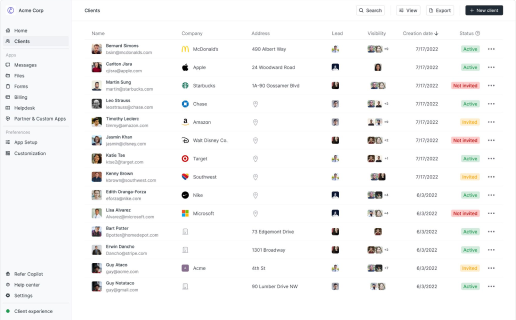
Run your design business on Copilot
Differentiate your web design agency with white-label portal that gives your clients a one-stop shop to access dashboards, submit tickets, send messages, make payments, and more.
4.9 rating
The way web designers make money has changed.
Gone are the days of simply charging hourly rates or offering mysterious retainers with vague deliverables. Today’s top agencies structure their pricing clearly and strategically.
Having worked at a web design company in the past, I know firsthand how wide the pay gap can be between beginner web designers and seasoned professionals. Some designers barely scrape by, while others charge five or even six figures per project. The difference? Creating effective web design pricing packages.
The best agencies package their expertise, value, and results in a way that clients can easily understand and buy into. They go beyond simply selling web design.
So, in this article, I’ll explain how to price your web design services. Then, we’ll go over five examples from real companies that have successfully packaged their services.
Alright, let’s get started.
How to price your web design services
Pricing your web design services is always tough. There are so many routes you can go down and there’s no one right way to go about it.
It all comes down to what you offer, who you offer it to, and how well you deliver. This is going to be different for everyone.
Some web designers just do design. Some do design and development. Some just do prototypes.
Some web designers work with big tech companies. Some help mom-and-pop shops. Some work with personal brands.
Some web designers work as freelancers. Some have a large team and built an agency. Some have been doing it for one year. Some have been doing it for over 10 years.
You get the point.
Lots of different factors. So, let’s look at some things to consider when creating your web design pricing packages for your clients.
Experience and past case studies
Right off the bat, one of the biggest factors to how much you can charge comes down to how good you are and how long you’ve been designing for the web. I know, it can be a harsh reality for those just starting out. But this is actually really exciting.
The more you invest in your craft, and work with better and better clients, the more your knowledge goes up as a web designer. And when your knowledge goes up, so does your experience. And with more experience, your perceived value goes up to potential clients.
The best way to showcase this to potential clients is to have a web design portfolio that is full of case studies of your past projects. If you have past notable clients, or even companies you’ve worked at in the past, you’ll be able to justify higher prices.
But even if you don’t have much experience, you can create your own. Showcase your own side projects or even fake mockups.
You can create and showcase web designs for fake brands you create. Or redesign existing brands (just follow legal guidelines here and mention they are fake mockups).
When we get into the five examples in the next section, I’ll show you how prices can change based on experience and past case studies.
Depth of your services
Next up is what you do and how well you do it. Setting up your web design pricing packages will depend on what types of services you offer.
For example, you can create a package that includes just web design mockups. And then you can also have a higher-tiered plan that includes web designs and web development (in Webflow or Framer). I’ll show you examples of this in the next section.
The other thing is also how good you are.
Design is subjective. But someone with great taste generally stands out over an old clunky design that looks like it's from 2010.
Having good taste is everything when it comes to not only web design but all kinds of design (both digital and physical). It’s a skill that can’t really be taught, but I know more people have it than don’t (you just have to believe in yourself).
There are ways you can refine and develop your taste. Check out how Dribbble or Behance for awesome designs. Or, my favorite, find lead designers at fast-growing tech companies and see if they have a personal portfolio with previous projects.
The better your taste, and the more services you can offer, the more you will be able to charge.
Your pricing model
Besides the first two factors we just talked about, what’s going to move the needle a lot is your pricing model.
I’ll get more into this in the next section, but you have to figure out how you’re going to charge clients.
Most web designers start off on an hourly basis. This works a lot when you’re collaborating with a brand that needs help with existing designs or parts of their website.
But the big bucks are going to come from having a per-project or monthly subscription type of pricing. This is going to come from brands that need a lot more work — be it a total website redesign, a complete design from the start, or something that’s going to need your ongoing help and attention (more on this last one later).
How you charge will play a big role in how much you make.
If you’re still early in your career, it might make sense to go with hourly. But if you’re a seasoned professional, you want to shift to getting paid for the value you bring, not the hours you put in.
Your financial goals and needs
Let me ask you a question: why do you think doctors make so much money?
If you think it’s because they deserve it then sure that could work. But the real reason is because doctors are responsible for people’s livelihoods. They need to be 100% invested in helping others. They can’t afford to have any mental energy spent on thinking about whether they’ll be able to pay their bills. If there are financial burdens in their personal lives, it’s going to affect how they show up as great doctors for their patients.
Solve the money problem and your mental capacity to help others goes up.
While I don’t want to compare the work of a doctor to a web designer, it’s important to understand that so many business problems stem from personal problems.
And one of the hardest personal problems is a financial one. Trust me, I’ve been there (multiple times).
If you’re not financially comfortable, it makes you work out of fear. And while that fear can be a motivator at times, it’s a source of energy that is not sustainable.
So when you’re creating your web design pricing packages, be honest with how much you need to make to be happy. If you’re getting lowballed and taking on projects you know don’t pay what you’re worth, it’s going to show in the quality of your services.
And if you’re getting paid well, sometimes more than what you think you deserve, you’ll go the extra mile to create something amazing for your clients. So keep this in mind when coming up with a price tag.
Alright, I can go over a million different pricing factors but these are really the core ones to think about. Now, we’ll go over five different pricing strategies, from real web designers, so you can gain some inspiration for your own pricing packages.
5 web design pricing packages (from real examples)
Here are some popular web design pricing packages:
- Hourly pricing
- Project-based pricing
- Monthly subscription pricing
- Custom quote pricing
- Performance-based pricing
Let’s go over each one with real examples.
1. Hourly pricing
The most common type of pricing most web designers start off with is an hourly rate. This is where you get paid for the amount of time you put in.
It’s great for those just starting out who want to grow their client roster and get some case studies under their belt.
One place you can gain some pricing inspiration, and even find work for yourself, is on Contra. It’s a platform that has been growing for designers of all kinds.
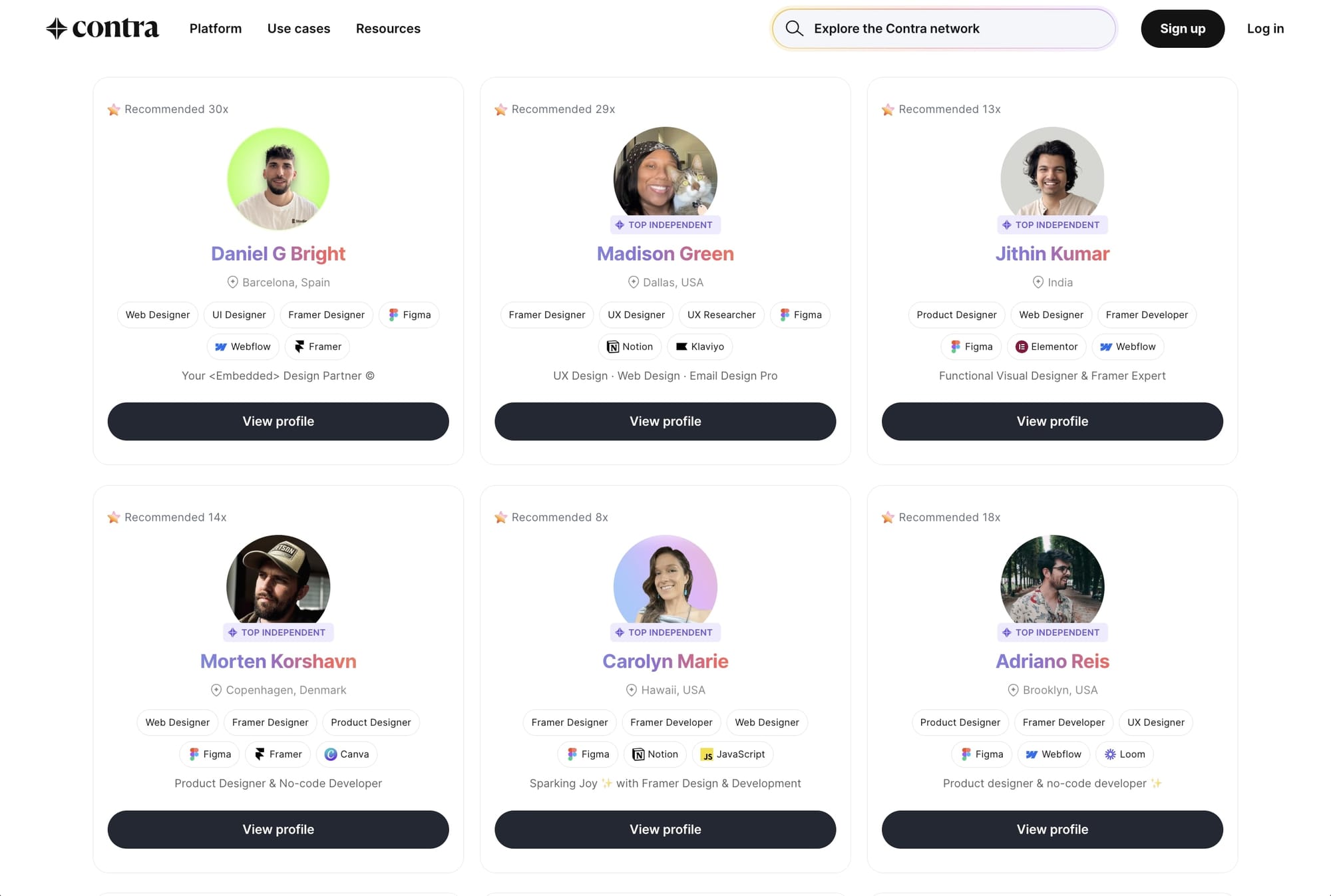
You can also look on Upwork and see what other web designers are charging for their hourly rates.
Of course, keep in mind pricing will depend on your location. On platforms like Upwork, you may find some people charging as little as $15 per hour. But if you’re in a first-world country, chances are you’d want to charge at least $50 per hour to make a project worth it.
As you gain more experience, you can even charge upwards of $100 per hour. This all depends on your experience and if you can show the value you’ve brought to businesses in the past.
2. Project-based pricing
Next up is project-based pricing. This is one of the most common pricing packages web designers offer. It gives clients a clear and upfront cost for a defined scope of work. This makes it easy for potential clients to see if your services match their budget. It also gives you predictability on how much you’ll get paid from a project.
I personally prefer this over hourly pricing, unless you know a project is going to take you a while to complete. If you’re fast at what you do, and provide great value, project-based pricing is a great way to go.
One example of a web design and product marketing agency that does this is Conversion Factory. They’ve successfully productized their services to offer multiple tiers depending on their clients’ needs.
For example, they have a fixed pricing model for design, copywriting, and Webflow development for $10K. And they deliver this in 3 weeks.
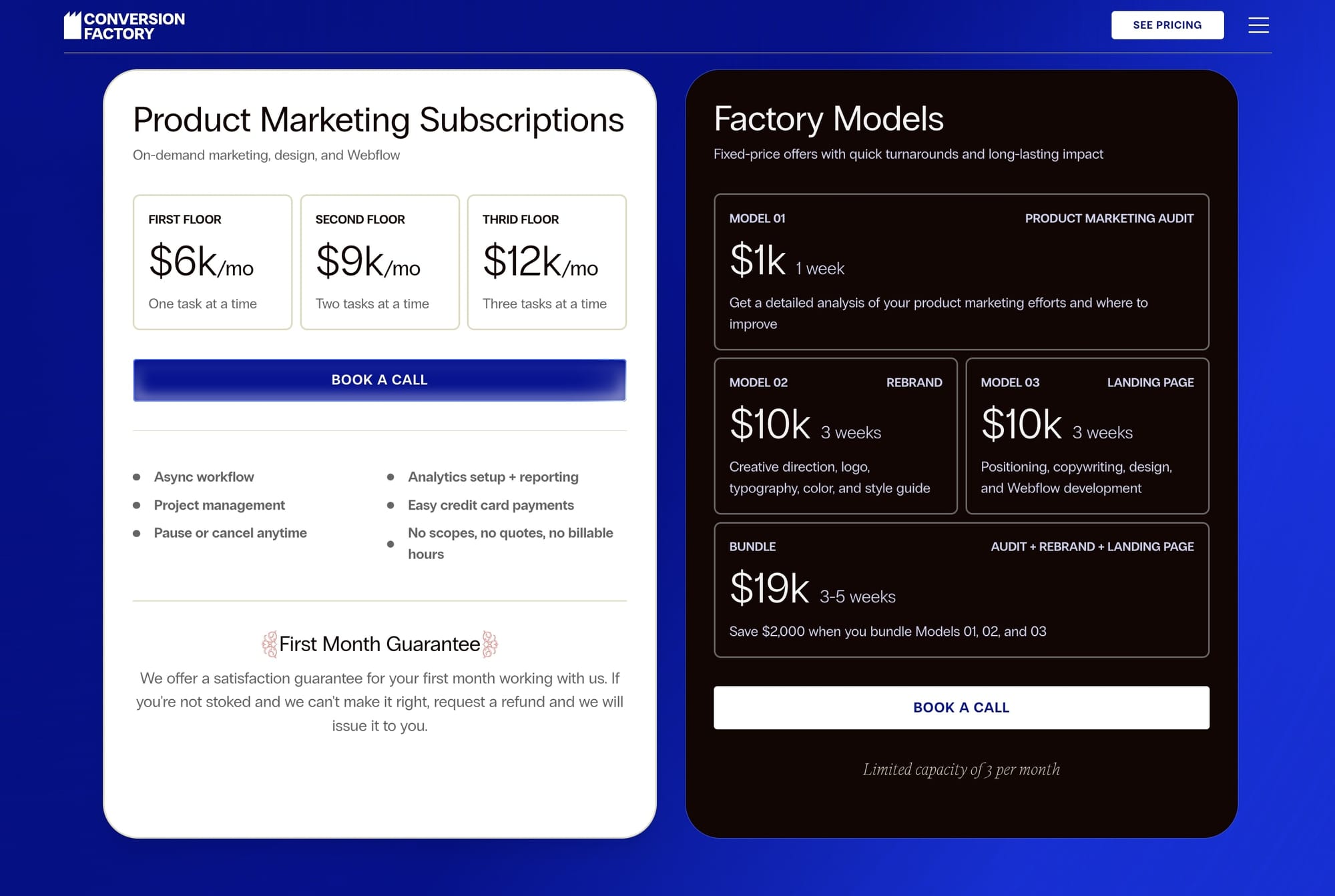
This is a great way to go about your web design pricing packages — productize your services into tiered plans. They’ve also leveraged monthly subscriptions, which we’ll go over in the next part.
3. Monthly subscription pricing
Next up is a pricing model that I’ve seen growing in popularity among web designers. This is probably my favorite type of pricing style out of all five we are going over.
What makes monthly pricing great is that your agency becomes more like a SaaS business. It also helps you compound your income by creating a recurring revenue stream.
One example of a web designer who’s pioneered this type of pricing is Designjoy.
Designjoy offers “design as a subscription” service to startups at a flat rate of $4,995 per month (at the time of writing this).
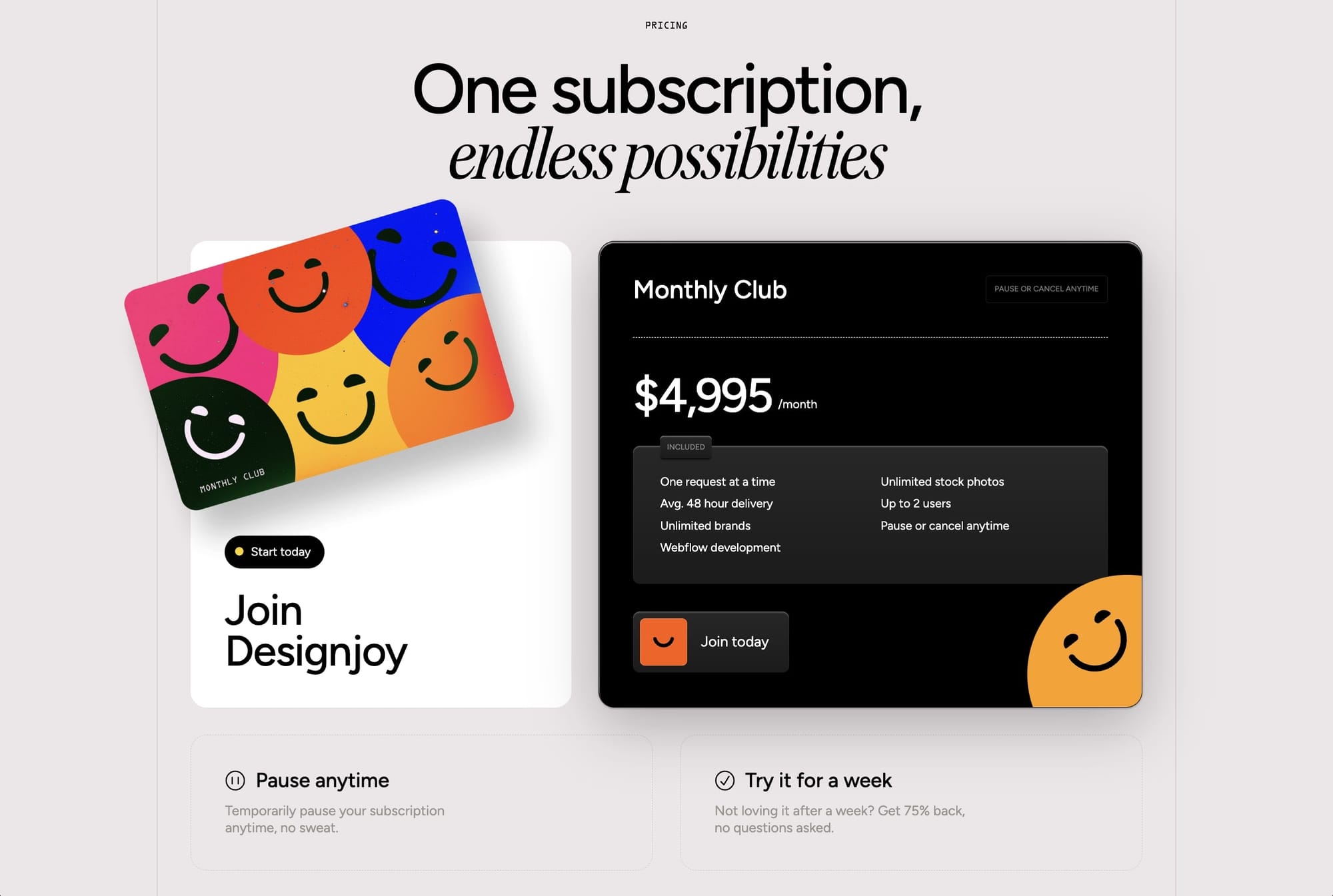
I know Designjoy has been around for a few years now, and I remember they didn’t start at this price initially. There are a handful of other service like this that charge less (and more).
The only thing with this pricing model is that you need to focus a lot on client retention. So I wouldn’t recommend this to web designers just starting out. This is for more experienced and advanced web design freelancers or agencies that understand how to deal with client relationships and know how to consistently deliver great services over an extended period of time.
4. Custom quote pricing
Up next is the most common web design pricing package for agencies. This is the typical custom pricing and retainer model most large agencies use.
You first understand what your client needs, then you give them a monthly rate that is usually packaged into a 3, 6, or 12-month contract. This way, you “retain” them for an agreed-upon timeline in your web design services contract.
There are lots of examples of web design agencies using this pricing, and one of them is Metalab — a popular UI/UX design agency.
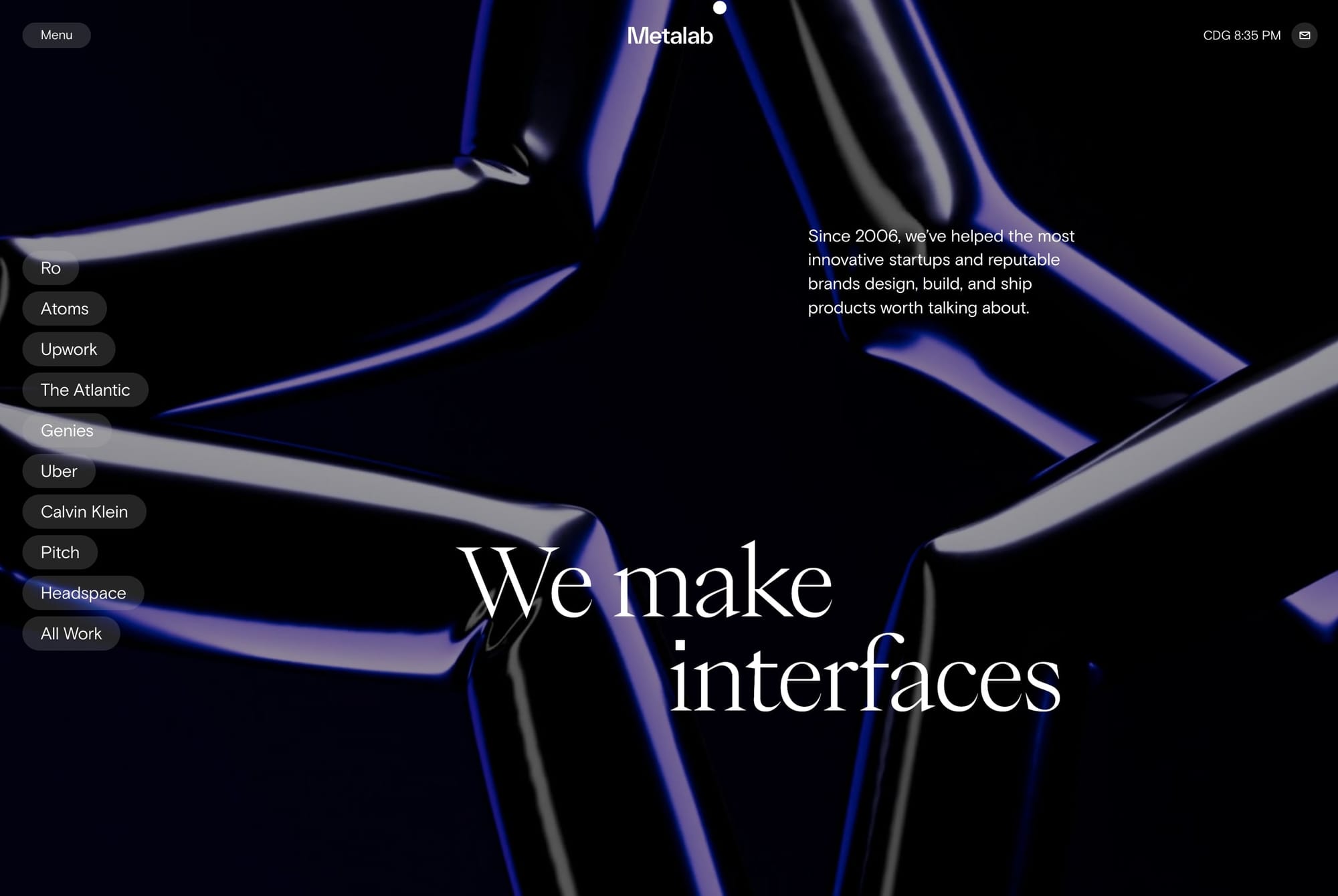
Metalab has worked with some big-name brands like Midjourney, Loom, Uber, Slack, and more. There’s a good chance they charge in the 6-figure range for their contracts, with many of them lasting many months or years.
It’s tough to gain inspiration from these types of companies for your pricing because they don’t publicly display anywhere. The only real way you’ll know how much these types of agencies charge is if you work with one of them or you hear about it from your circle of friends.
But, it’s no doubt that these are the types of web design services that make the most money. So there is something to learn about how they present themselves publicly online.
5. Performance-based pricing
Last up, we have performance-based pricing. This is not a very common pricing model for web design services. It’s mostly seen in marketing agencies that aim to give their clients some sort of ROI that is easily attributed and tracked.
When it comes to web design agencies, it’s a bit harder because it’s hard to attribute designs directly to new customers for a client. However, it’s not impossible.
If you sell web design services that aim to improve a client's website, this is a pricing strategy worth checking out. One example you can look at is Spiralyze — a CRO (conversion rate optimization) agency that specializes in design, copywriting, research, and development.
Spiralyze leverages two types of pricing — a monthly plan and a performance-based plan.
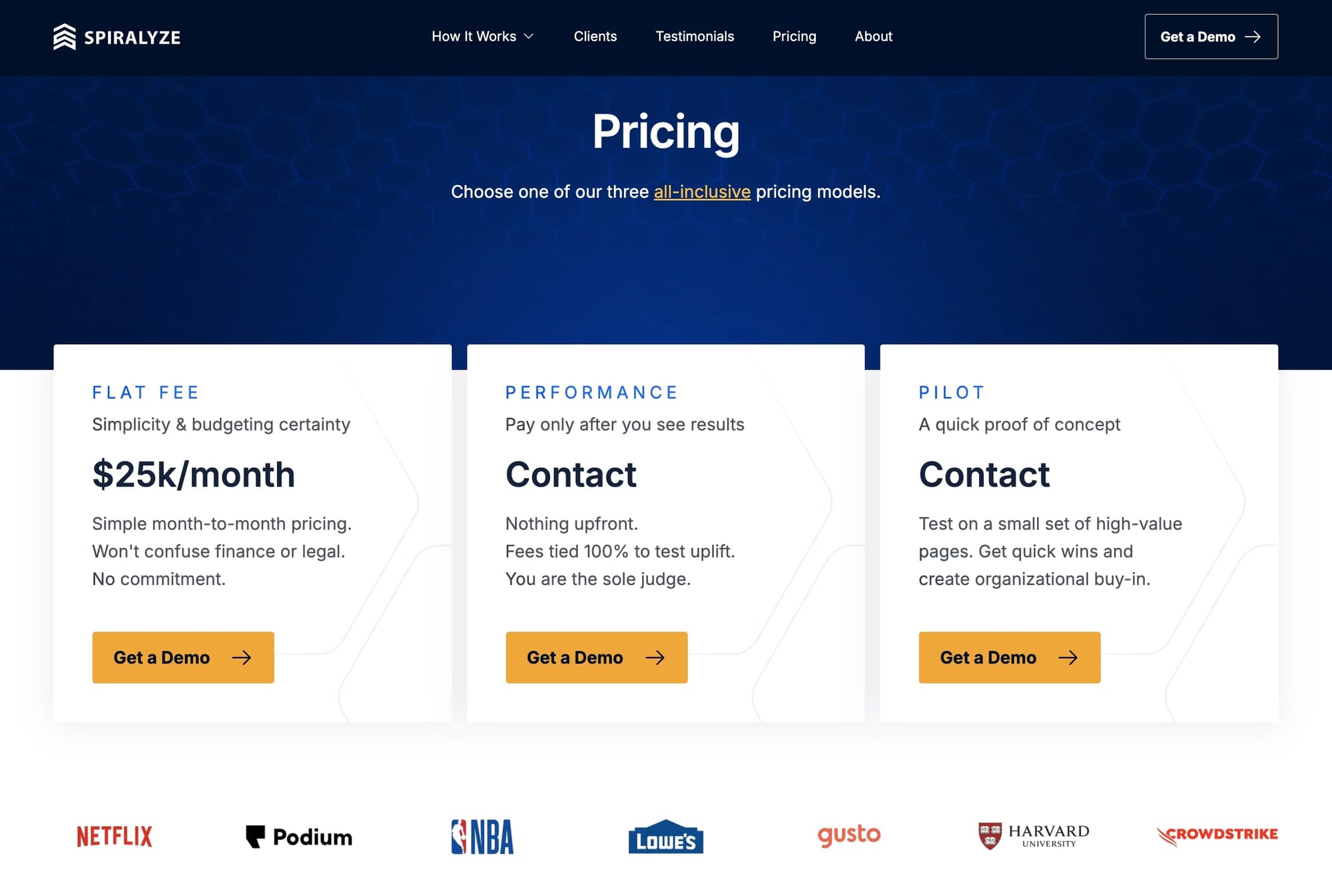
The performance-based pricing model says that your clients only pay after they see results. This way, it minimizes risk for your client. But, it puts all the risk on you to deliver.
I’ve also seen this work with performance marketing agencies that do a revenue share model. For example, there is no monthly fee for a client, but if the agency can drive new business, it gets a certain percentage of the new revenue generated.
This way, there is no ceiling to the amount of money you can make from a client. The more results you drive for a client, the more money in your pocket.
Create a modern web design agency
As you can see, there are a lot of different ways you can package your pricing and services in a web design business. Oftentimes, you can even provide two or more pricing packages (as we saw with a few examples) to give potential clients optionality.
But signing clients is just one part of running a service-based business. You need a platform that can help you onboard clients, bill them (through any pricing model you desire), message them, send them contracts to sign, upload files, and present your deliverables in a custom dashboard that makes your business feel premium.
This is where Copilot comes into play.
With Copilot, you can streamline your entire client management process, making it easier to win clients, keep projects organized, and create a high-end experience that sets your agency apart. Instead of juggling multiple tools, Copilot provides an all-in-one platform where you can:
- Set up custom pricing models (hourly, project-based, or retainer)
- Onboard new clients seamlessly with branded portals and automated workflows
- Send invoices and accept payments in just a few clicks
- Manage communication through a dedicated client messaging system
- Deliver final projects through a sleek, branded client portal
Try it for yourself! 👇
A seamless, well-organized client experience leads to higher retention rates, encouraging clients to return for future projects and long-term collaborations. When your agency operates smoothly, clients are more likely to trust you, refer others, and continue working with you over time.
If you're ready to take your web design agency to the next level, give Copilot a try today.
Share this post
Sign up for our newsletter
Subscribe to our newsletter to receive emails about important announcements, product updates, and guides relevant to your industry.
